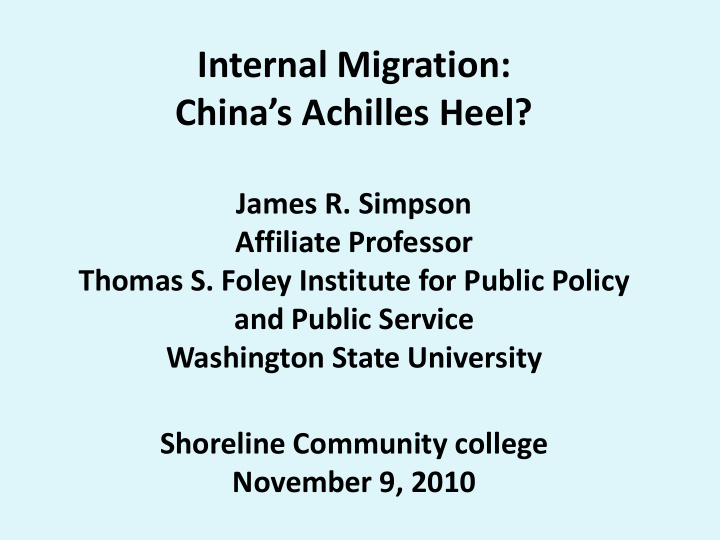



Internal Migration: China’s Achilles Heel? James R. Simpson Affiliate Professor Thomas S. Foley Institute for Public Policy and Public Service Washington State University Shoreline Community college November 9, 2010
What’s the Problem? • The pastoral and grassland area (called the grasslands) of China occupies about half of its land mass • 20-30 percent of the of the grassland is overgrazed leading to continual increased degradation • Grassland human population continues to grow leading to ever smaller size livestock units per herder family • China is developing rapidly, contributing to pockets of “economic and cultural poverty
Critical Questions to be answered in this presentation • What are the land use and production systems in China’s pastoral areas? • To what extent and how should stakeholders and governmental authorities carry out restoration of degraded land and environment land tenure and land management rights? • Should land use laws be promulgated that promote wide scale migration from pastoral areas in the name of social and societal development? • To what extent should pastoral stakeholder perspectives be taken into account on social issues and resource planning? Achilles heel — a (the) vulnerable point. From the story that Achilles was only vulnerable in his heel.
Conclusions and Messages • Grassland protection and rejuvenation depends on two factors • Reduction of human population • Reduction of livestock numbers • Strict surveillance and control of livestock grazing pressure by the state (national and provincial) is essential — a must • Recognition that China’s pastoral area issues are a “commonality” problem is behind reasoning, rational, logic and theory
China’s Grassland law Article 1. This Law is formulated in accordance with the provisions of the Constitution of the People's Republic of China with a view to improving the protection, management and development of grasslands and ensuring their rational use; Article 4. The grasslands are owned by the state, that is, by the whole people, with the exception of the grasslands that are owned by collectives in accordance with the law. Article 12. Grasslands shall be used rationally and overgrazing prevented. Where aridity, degeneration or soil erosion occurs as a result of overgrazing, users of the grasslands shall be required to reduce grazing and re-sow forage grass so as to restore vegetation.
Typical nomadic herder family in northwest Xinjiang 14 cattle, 22 goats 145 sheep, 11 horses, 12 camels Net cash and in-kind income above direct cash expenses plus family labor $6,987
Conclusions about migration. There are three candidates • Nomads. Net cash and in-kind income above direct cash expenses plus family labor $6,987 • Bao Shan, small size cattle and goat herder, Northeast Inner Mongolia. Net cash and in-kind income above direct cash expenses plus family labor $338 • Aorizhabu, very small herder, Hurqige Gacha, Inner Mongolia. Net cash and in-kind income above direct cash expenses plus family labor $402 • et cash and in-kind income above direct cash • expenses plus family labor $6,987 • et cash and in-kind income above direct cash • expenses plus family labor $6,987 • t cash and in-kind income above direct cash • expenses plus family labor $6,987
Some options on migration to mitigate the pastoral area “Problems” • 1. Do nothing. Just let the free market handle the issues • 2. Recognize there is a land tenure problem, and focus on state enforcement of existing legislation to result in greater migration out of the livestock sub-sector • 3. Develop an national plan based on optimal grazing pressure using land set asides and reduction of land rights and grazing certificates as a way to induce migration out of the livestock sub-sector • 4. Develop proactive new legislation and strong enforcement to really force needed migration
Recommend
More recommend